Wildflowers are one of Mother Nature’s loveliest gifts. Their changing panorama of colors, shapes, sizes and heights provides delight throughout the seasons. Wildflowers can be used anywhere. In the home landscape they are ideal for creating colorful beds and borders, as well as offering a lower-maintenance alternative for large areas or replacing turf grass. Wildflowers can be planted to cover large, open areas or assist in the recovery of a landscape that has been damaged or destroyed by the actions of people, a natural disaster, or the spread of invasive plants.

WHAT IS A WILDFLOWER?
Wildflower is not an exact term that is well defined. Some people say a wildflower is a plant that was not intentionally seeded or planted and grows without cultivation. Others classify a wildflower as any plant growing without the help of man regardless of the plant’s country of origin. Still others define a wildflower as a plant found in a specific geographic area that was grown from seed or plants also from that area.
Wildflowers and other plants that were growing before European settlement in what we now call the United States, Canada and Mexico are called native plants or indigenous species. Other plants, often referred to as exotics or aliens, were originally brought here from another part of the world. Many exotic species including flowers, grasses, trees and shrubs are among our favorite garden plants. A few, including some wildflowers, have escaped and become established as part of a local environment or naturalized. Some exotic species have even become invasive and are considered noxious weeds that need to be eradicated.
HISTORY OF WILDFLOWERS
Many of our favorite wildflowers have been growing in European gardens for centuries. Even some of our native wildflowers enjoyed more popularity in Europe than in the U.S. where they went unnoticed by gardeners. When early explorers came to North America, they discovered the bounty of plants growing in the New World. They eagerly brought many of these plants back to Europe where they were sought after by gardeners wanting something new and different for their gardens.
During colonial times, ornamental flowers were often grown in the Pleasure Garden or Pleasure-Ground, the designation for the flower garden. President George Washington had flower gardens at his home but most of his written notes were about the trees and shrubs he planted at Mt. Vernon, One native wildflower that Washington did plant and record was Cardinal Flower (Lobelia cardinalis). He probably grew many foreign or exotic flowers since Washington avidly collected and traded plants with correspondents in Europe.

Cardinal Flower
To Purchase The Cardinal Flower Visit Us At Ion Exchange, Inc.
President Thomas Jefferson, an avid horticulturist, plant collector and seed saver, grew wildflowers in his garden. He also noted planting Cardinal Flower after it was recommended by his nurseryman friend, Bernard McMahon, who included it in his 1806 book “The American Gardener’s Calendar”, the first horticultural reference for American gardeners. While Cardinal Flower may have been one of the first trendy plants in the New World, it’s interesting that this North American native wildflower was introduced in Britain in 1626, more than 150 years before being mentioned in American references. McMahon noted “Here we cultivate many foreign trifles and neglect the profusion of beauties so bountifully bestowed upon us by the hand of nature.”
Other plants in Jefferson’s garden may have been from the 290 native plants described and collected by Meriwether Lewis during the Lewis and Clark Voyage of Discovery in the early 1800’s. More than half of the plants were new discoveries to white people including Lewis Flax (Linum lewisii) (one of many plant species named after either Lewis or Clark) and Scarlet Globemallow (Sphaeralcea coccinea). They also described Blanketflower (Gaillardia aristata) and Purple Coneflower (Echinacea purpurea).
Informal and wildflower gardens became fashionable with the publication of The Wild Garden in 1870 by England’s William Robinson who described them as “a delightful feature of a place”. This style of garden contrasted with the highly manicured and formal designs that had been popular in American and Europe. Wild gardens featured hardy, herbaceous plants, including both native and exotic species. They were designed and placed where they would thrive with little additional care.
The cottage and old-fashioned gardens of the 1800’s also included a few native perennial wildflowers but mostly focused on designs that included peonies, hollyhocks, phlox, roses, violets and other European favorites. By the end of the 1800’s many landscape designers began to emphasize hardy herbaceous plants in recognition of their lower maintenance. Noted horticulturist and botanist Liberty Hyde Bailey wrote, “The interest in native plants has never been so great as now.”
Wildflowers and native plants have continued to attract attention throughout U.S. gardening history. They are currently experiencing a resurgence in popularity by both gardeners and public officials for their beauty and their valuable contributions to the environment.
WHY PLANT WILDFLOWERS
A garden of wildflowers offers benefits to both the gardener and the environment. Once established, properly chosen wildflowers require less maintenance than traditional landscape plantings which can mean less watering, fertilizing, pest control and mowing. Some plants have deep root systems that prevent water run off and soil erosion, and enable them to withstand drought. Their growth also brings earthworms and beneficial soil microorganisms to enhance soil health. And colorful blossoms can be arranged into lovely, casual bouquets that brighten the home.
Flowers provide nectar and pollen sources for bees, butterflies and other pollinators, while ripened seeds are a food source for birds and wildlife. Current research suggests that native plants and flowers might be more attractive to native bees than exotic flowers. Even a small area in a garden or landscape planted with wildflowers that bloom at varying times throughout the growing season helps attract and support pollinators.
SOME POPULAR PERENNIAL WILDFLOWERS
Many of these beautiful yet hard-working plants are equally at home in garden beds and borders as they are in larger wildflower plantings and restoration projects. Purple coneflower (Echinacea purpurea), California poppy (Eschscholzia californica), columbine (Aquilegia canadensis), butterfly weed (Asclepias tuberosa), and black-eyed or brown-eyed Susans (Rudbeckia triloba and R. hirta) are among the popular wildflowers planted by American gardeners, all of which happen to be native to the U.S.
One of the most admired wildflowers is Purple Coneflower (Echinacea purpurea). It is native to the Midwestern prairies and dry, open woods of the Southeast but can be found in gardens from Maine to California because it is fairly adaptable to most types of soil and does well even in dry conditions. Plants flower from late spring to early fall attracting butterflies and bees to the large, purple, daisy-like flowers. After the long-lasting blooms drop their petals, the distinctive seed heads develop and provide food for goldfinches and other birds. (Zones 3-8)
Wild Bergamot (Monarda fistulosa) is native to a large part of the country including the Northeast, Midwest and Rocky Mountain region. Also called Beebalm, the whorls of pink to lilac colored flowers open in summer to attract bees, hummingbirds and a variety of other pollinating insects. It gets the name Wild Bergamot from the aromatic leaves that have a scent reminiscent of the bergamot orange tree of Europe. Monarda had many medicinal uses to the Native Americans. Today the leaves are often used to make tea. Plants do best in dry open areas and woodlands but can grow in moist soils as long as they are well drained. (Zones 3-9)
Eastern Columbine (Aquilegia canadensis) despite its species name is native to the East and Midwest U.S. as well as eastern Canada. It is one of about 30 species of Columbine found in North America. Columbine is often found in a shady woodland setting though they have a deep taproot that enables them to grow in dry sites. The colorful red and yellow flowers that open in spring and summer are a favorite of hummingbirds. Blue Columbine or Rocky Mountain Blue Columbine (Aquilegia caerulea) has beautiful blue and white flowers and is one of the many columbines found in the western U.S. It is the state flower of Colorado. (Zones 3-9)
New England Aster (Symphyotricum novae-angliae, previously Aster novae-angliae) is a favorite of many gardeners for the beautiful violet-purple flowers that cover the plant in fall. Its native range is from New England all the way west to the Rocky Mountains and as far south as Tennessee and North Carolina. Plants grow best in areas with full sun and moist but well-drained soils. Valuable in the garden and any wildflower planting for its late season color, New England aster is also a nectar source for Monarch butterflies as well as attracting native bees and pollinators. (Zones 3-7)
California Poppy (Eschscholzia californica) is perennial in its native California but grown as an annual in colder climates. Spanish explorers who saw the California hillsides covered with the golden orange poppies called the area the Land of Fire. It was introduced into European gardens in the 1830’s. California Poppy has golden-orange, silky, saucer-shaped flowers that open during the day and close at night or on cloudy days. Plants bloom best in the cool weather of spring and fall. In mild climates it will bloom several times during the year. In colder climates, it may self-seed in the spring and flower again in the fall. California Poppy is the state flower of California. (Zones 8-10)
While some perennial wildflowers adapt to a range of growing conditions and will grow throughout the U.S., other wildflowers prefer a specific region of the country or very specific environmental conditions. Chocolate Flower (Berlandiera lyrata) is a delightful treasure with cute, yellow, daisy-like flowers that exude the smell of chocolate in the morning. However, it is native to the dry parts of Kansas, Colorado and south to Arizona into Mexico so it loves hot sun and poor dry soils. Grow it in soil that’s even halfway decent and it gets leggy and flops over. (Zones 5-9)
Indian Paintbrush (Castilleja sp.) is another much admired wildflower that seems to grow without care in its native environment that ranges throughout North America depending on the species. It derives its name from the striking orange-crimson spikes that appear in spring and resemble a brush dipped in paint. However, Indian Paintbrush can be difficult to grow from seed and establish in the garden. They are considered hemi-parasitic which means they need to grow in close proximity to other wildflowers and grasses. Indian Paintbrush produces roots that attach themselves to a range of plants that grow nearby to obtain some nourishment. Without these host plants, Indian Paintbrush declines and eventually dies. It is a challenge for even experienced gardeners but could surprise you if planted in the right conditions. (Zones 3-9)
HOW TO GROW WILDFLOWERS
Liberty Hyde Bailey once said “A garden requires patient labor and attention. Plants do not grow merely to satisfy ambitions or to fulfill good intentions. They thrive because someone expended effort on them.”
Growing wildflowers requires the same type of care as traditional ornamental plants. Start with high quality seed and healthy plants. Be sure to select varieties that are suited to your conditions. Wildflowers will grow and bloom best when the environmental conditions meet their requirements. Sun exposure, availability (or lack) of moisture, and soil type all affect plant growth.
HOW TO CHOOSE WILDFLOWERS
Before purchasing seed or plants, think about what you are trying to achieve with your planting. If you want only native wildflowers in your garden find out what is native to your region and what type of growing conditions are needed. Do you want to attract bees and other pollinators or encourage butterflies to visit your garden? Look for plants that produce the type of flowers preferred by these insects. Are you interested in a garden that is filled with color from spring to fall? Choose a mix that has a variety of flowers and bloom times.
Some wildflowers have very specific soil, water, light, temperature and fertility requirements and won’t grow outside of a specific geographic range or set of conditions. Others are easier to grow because they have adapted to a wide range of environments. Does the plant like full sun, partial sun or a shaded location? Does it require constant moisture or will the plant survive periods of drought during the year? Does the plant like rich, fertile soil or does it grow better in a poor soil with lower fertility. Choose plant varieties that are matched to the conditions of your site.
Many types of wildflower mixes are available from seed suppliers. Some mixes contain only native wildflowers and may be formulated to grow in a defined geographic region or climate. Other mixes contain varieties that are both native and exotic. Some mixes have a balance of annual and perennial species to provide fast color and long-term beauty. Other mixes contain mostly annual flowers for a quick-growing wildflower garden. Not all of the wildflowers contained in mixes will grow in every garden but there are usually enough different types in each mix to provide a nice variety. Remember that successful wildflower gardens are created over many years as plants that are best adapted to your garden conditions become established and thrive.
There are many sources available to help you find the best native wildflowers for your garden. The Xerces Society (www.xerces.org) has several fact sheets and publications that suggest good native plants for geographic regions in the U.S. The Lady Bird Johnson Wildflower Center has an extensive database of commercially available native plants that can be searched to provide recommendations by state (www.wildflower.org). Local native plant societies and government organizations are also good sources of regional information.
PREPARING THE SOIL
The next step in creating an eye-catching field of flowers is to prepare the soil by removing weeds and other unwanted vegetation. If the soil is compacted, till lightly so the soil is loose and germinating seeds can put down roots. A bow rake is great for loosening the top layer of soil. Digging or roto-tilling too deep will bring up weed seeds and other plants that will need to be removed later to avoid competing with the wildflower seeds. While it may not be practical or necessary to amend the soil before planting wildflowers, you can add organic matter such as compost or well-rotted manure before planting depending on the site.
PLANTING FROM SEED
Wildflower seed and seed mixes can be planted in either spring or fall. Spring rains help seeds germinate and plants get established before many weeds have a chance to grow. In warm climates, fall is a good time to plant wildflowers when cooler temperatures and winter moisture provide better conditions for seed germination and growth. In cold climates, a dormant seeding of wildflowers can be done in the fall when temperatures are low enough that seed will not germinate until weather warms up the following spring, similar to what happens in nature. Some seeds, especially many of our native perennial wildflower species, need a chilling period to break their dormancy. This is provided naturally by the change in temperatures from winter into spring.
Scatter seeds by hand or with a small spreader. Seeds can be raked into the soil or lightly covered with soil. Water thoroughly right after planting and keep seeds and seedlings moist for about 4-6 weeks. Gradually reduce watering as seedlings develop. Identify and remove weed seedlings as soon as possible since they will compete with wildflowers for water, nutrients and space. For dormant seeding, watering after planting seeds is not necessary.
CARE OF THE WILDFLOWER GARDEN
A wildflower planting just like a colorful meadow created by Mother Nature will look different from month to month and year to year. Annual flowers are more abundant at first because they grow and flower quickly. In following years perennial plants become established and start flowering, in addition to annual flowers that may reseed themselves.
The first year is a time to help wildflowers get established. Not all seeds will germinate right away but may be waiting for the right environmental conditions before they begin to grow. This is especially true with perennial wildflowers so don’t get discouraged or be disappointed if you don’t have that instant flower meadow. For more immediate results you may want to combine seeding wildflowers with planting a few container-grown plants. Plants will quickly get established and compete with weeds that may appear. Be sure to identify and remove weeds when they are small to prevent them from spreading Depending on needs of your wildflowers provide additional water if rainfall is sparse, especially during periods of extended hot temperatures. Avoid cutting flowers after they bloom so they can go to seed. Seed will drop to the ground and spread to fill in your planting.
During the second year, you may see new plants grow from seeds that didn’t germinate the first year. Water if rainfall is not adequate, especially in the spring. Additional water may be needed in the summer during extreme or extended periods of hot weather. Continue to remove weeds as they appear. As wildflowers become established the need to weed should taper off. Fill in bare spots with additional seed or container-grown plants.
After the third year and beyond your wildflower planting should require minimal maintenance. Remove large weeds that may move in. You may want to move plants that have grown too close and are crowding each other. Use them to fill in bare spots or sow additional seed to cover those spots. Additional water may be needed in the summer during extreme or extended periods of hot weather. Fertilizing is generally not required. In a garden setting, you can mulch around established plants with compost or well-rotted manure. Cutting or mowing wildflowers in fall to a height of about 6 inches will keep the planting looking neat and help spread seeds. Periodically disturbing the soil by digging or raking can also help regenerate a wildflower garden by creating good soil contact with seeds that have fallen to the ground.
Some wildflowers, especially prairie plants and grasses, benefit from being burned every few years. Fire occurs in many ecosystems as a way to get rid of woody plant invaders that move into a site as part of natural plant succession. Fire also helps break the dormancy of some seeds and stimulates the growth of other species. However, burning should only be done by someone with the understanding and expertise to do it safely and effectively. In the home landscape mowing, hoeing, digging and other means of soil disturbance can achieve the same goal.
WHERE TO BUY WILDFLOWERS
Gardeners have many choices when creating a wildflower garden. Local nurseries and garden centers sell both seeds and live plants. Retail, Internet, and catalog seed companies sell wildflowers as individual species and mixes. Many seed companies also sell mixes for a variety of special uses—wildflowers for cutting, fragrance, partial shade, attracting butterflies or pollinating insects, and more.
Digging plants from the wild is not recommended and might be illegal. State and federal laws protect some native plant species that are threatened or endangered. Collecting seed must be done carefully. Removing too much seed could reduce or destroy a wild plant population.
The National Garden Bureau has several members that sell wildflowers including many North American native wildflowers. Choosing the right plants for your wildflower garden will create a beautiful landscape to be enjoyed for many years.
For More Information
Please consider our NGB member companies as authoritative sources for information. Click on direct links to their websites by selecting Member Info from the menu on the left side of our home page. Gardeners looking for seed sources can use the “Shop Our Members” feature at the top of our home page.
Photos can be obtained from the NGB website in the area labeled “Image Downloads”.
The National Garden Bureau recognizes Janis Kieft of Botanical Interests Inc., as the author of this fact sheet and Gene Milstein and Diane Wilson of Applewood Seed as expert contributors. Photography was contributed by Applewood Seed Company.
This Article “Year of the Wildflower” Fact Sheet is provided as a service from the National Garden Bureau.
For All Your Native Wildflowers & Prairie Plants Please Visit Our Website at Ion Exchange, Inc.
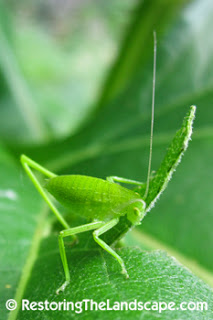 They perform important ecosystem services, pollinating the plants in our landscape, and preying on foliage eating insects, crickets and katydids in particular.
They perform important ecosystem services, pollinating the plants in our landscape, and preying on foliage eating insects, crickets and katydids in particular.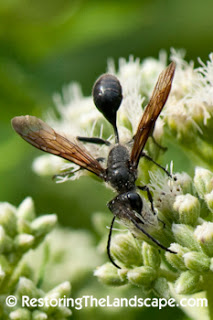 The prey are stocked for their developing larvae to feed upon. Using nearby grasses, nests are divided into sections with pieces of grass, they also close the end of nest with grass.
The prey are stocked for their developing larvae to feed upon. Using nearby grasses, nests are divided into sections with pieces of grass, they also close the end of nest with grass.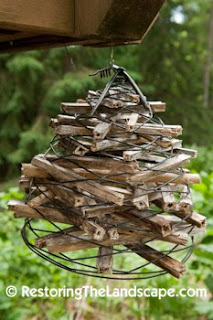 If you erect a mason bee nest board (board with nesting holes drilled in it), grass-carrying wasps will sometimes build nests in the cavities. Look for pieces of grass sticking out the ends of the board holes or plant stems.
If you erect a mason bee nest board (board with nesting holes drilled in it), grass-carrying wasps will sometimes build nests in the cavities. Look for pieces of grass sticking out the ends of the board holes or plant stems.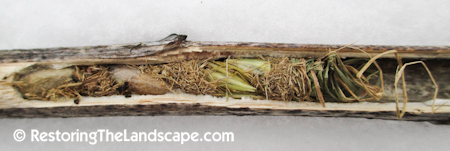 Here’s a cross-section of one of those stems with the wasp larvae and stocked prey. In my yard, the grass-carrying wasps like to use little blue stem to seal off the cavities.
Here’s a cross-section of one of those stems with the wasp larvae and stocked prey. In my yard, the grass-carrying wasps like to use little blue stem to seal off the cavities.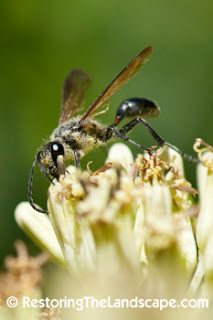 Look for grass-carrying wasps in late summer. In my yard, they like to visit stiff goldenrod, common boneset and pale Indian plantain flowers for nectar.
Look for grass-carrying wasps in late summer. In my yard, they like to visit stiff goldenrod, common boneset and pale Indian plantain flowers for nectar.
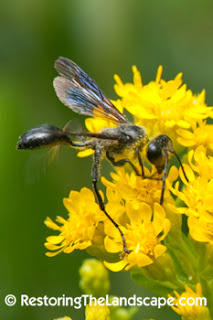







![Reblog this post [with Zemanta]](https://i0.wp.com/img.zemanta.com/reblog_e.png)

